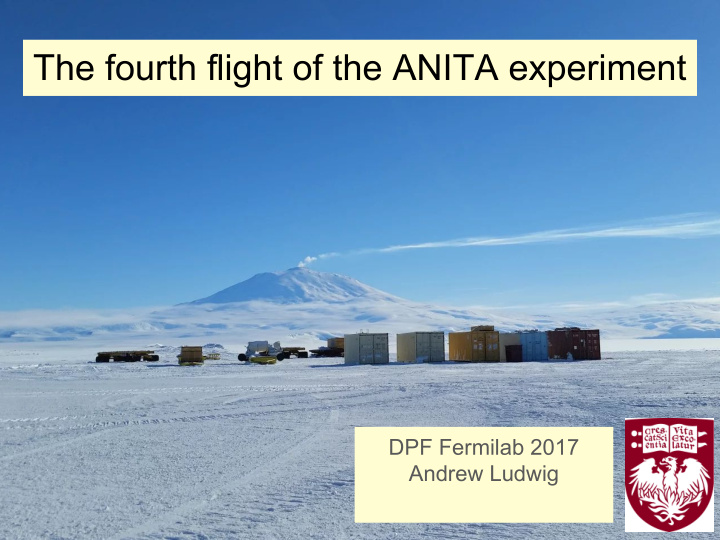



The fourth flight of the ANITA experiment DPF Fermilab 2017 Andrew Ludwig 1
Outline Ultra high energy neutrinos ANITA instrument - Neutrino detection - Cosmic ray detection Previous ANITA results ANITA-4 flight - Improvements - Data Next steps 2
Ultra high energy (UHE) neutrinos UHE defined as > ~10 18 eV Neutrinos make great messengers One source of UHE neutrinos is the GZK process: Protons with energy > 10 19.5 eV will interact with CMB photons in a Δ + credit: J. Nam resonance: nucleon Charged pions decay into a muon and neutrino that will decay and produce more neutrinos: GZK process (credit: W. Bietenholz) 3
The ANtarctic Impulsive Transient Antenna (ANITA) 48 antennas - Dual polarization - Directional - 200 - 1200 MHz band Solar powered Flies at altitude of 37-40km Over 1 million km 3 ice visible 4 credit: S. Prohira
Why Antarctica? Radio quiet Lots of thick ice Ice is radio transparent (~1km attenuation length) Conveniently, location of NASA’s long duration balloon program 5
Neutrino detection mechanism: the Askaryan effect First observed in 2001 Coherent radio emission from negative charge excess in EM shower Shower is actually a thin disk of particles Coherent at wavelengths longer than the radius of disk Polarized radially credit: C. Deaconu 6
Cosmic ray detection with geomagnetic radiation Cosmic rays cause an EM shower Due to Lorentz force, shower is curved around the Earth’s B-field lines Polarized mostly horizontally Forward beamed radiation is picked up directly or reflected off the ice credit: C. Deaconu 7
Results from previous flights ANITA-1 unexpectedly found 16 cosmic rays ANITA-2 still has the best limits on UHE neutrino flux above 10 19.5 eV ANITA-3 results are nearly complete ANITA-4 results are in progress credit: A. Connolly 8
ANITA-3 problems 9 credit: NASA
ANITA-4 flight ANITA-4 Flight Path Flew for 28 days Data was recovered in January 10 ANITA at float (40km up)
ANITA-4 improvements Triggering favors linearly polarized signals Notch filters that were tunable in flight 1 of 96 Tunable Universal Frontend Filters (TUFFs) (credit: O. Banerjee) Cabling up the signal chain (credit: E. Oberla) Example of notch being dynamically re-tuned in flight to block out continuous waveform noise (credit: O. Banerjee) 11
ANITA-4 data 12
ANITA-4 calibration Phi res: 0.65 degrees Phi res: 0.35 degrees Theta res 0. 21 degrees Theta res 0. 13 degrees Phi res: 0.39 degrees Phi res: 0.58 degrees Theta res 0. 14 degrees Theta res 0. 24 degrees Calibration pulser setup (credit: E. Oberla) 13
What’s Next for ANITA Results for ANITA-3 soon Results for ANITA-4 out within the next year ANITA has a pending proposal for a 5th flight with: - Phased array type triggering - New electronics for greater sensitivity, record length, buffer depth My favorite ANITA picture 14 (credit: E. Oberla)
Thanks! Thanks to A. Vieregg and C. Deaconu for their frequent help Thanks to NASA’s Scientific Ballooning Facility engineers and launch crew for excellent support. 15
Recommend
More recommend